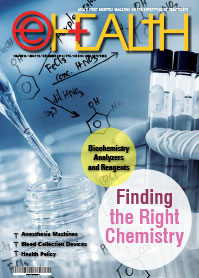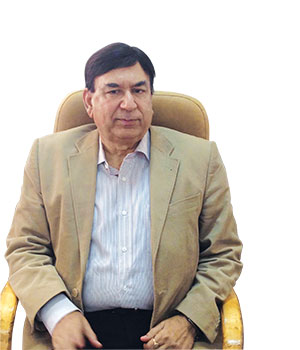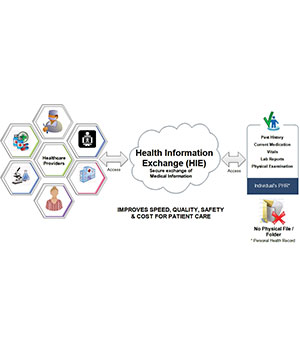
 Automation is certainly the future trend that will completely take over the manual segment and dominate the whole market, with the high price competition eventually eroding the profit margin of the manual devices segment
Automation is certainly the future trend that will completely take over the manual segment and dominate the whole market, with the high price competition eventually eroding the profit margin of the manual devices segment
A spurt in new infections surfacing the world over remains a huge concern to the blood banking and blood products industry. Though awareness amongst consumers and health workers helped in reducing the intensity of infection, the industry is yet to free itself of various problems such as safety, and availability of quality blood. The awareness has also resulted in the implementation of stringent safety standards for both donors, and blood screening banks to be adhered to before any transfusion. Rigorous testing and screening procedures, along with the help of new technology have sufficiently reduced the threat of diseases being transmitted through transfusions. Though the overall situation has improved, instances of diseases spreading through blood transfusion are still common in the developing and underdeveloped countries. Awareness campaigns in these countries have also drawn flak, with only a few donors volunteering.

Market dynamics
The blood banking and blood productsmarket is exhibiting a healthy trend. The blood collection devices market is expected to grow further in the coming years owing to continuous developments and rising demand for better blood collection and transfusion technology. The global blood processing devices and consumables market was valued at Rs.194,059 crore in 2013 and is estimated to reach a market worth Rs.294,960 crore in 2019 at a CAGR of 8.9 percent from 2014 to 2019.
The growth of the market is driven by factors such as increase in ageing population, increasing cancer therapies, emergence of infectious diseases (HIV and hepatitis), and significant rise in surgical procedures. In addition, strict government regulations across the world are also positively impacting market growth. Moreover, manufacturers are developing improved and automated products for collection, processing, and storage of blood and blood components. According to WHO, it is estimated that global population over age 60 years would double from 11 percent (2000) to 22 percent (2050).
People aged 60 and above are more prone to cancer risk and other surgical procedures. Hence, greying population and increasing demand for cell therapy will act as driving factors for the growth of this market.

Blood processing devices market is a rapidly developing field and has been witnessing numerous technological advancements. Growth of the market is influenced by the rising demand for pathogen-free blood. Blood being a vital component of the body is routinely used in a wide range of hospital procedures for transplantations, cancer therapies, and other forms of surgeries. Therefore, safe blood supply is integral in surgical and other blood transfusion procedures.
Blood processing devices and consumables market are witnessing intense competition among the players, which are willing to offer complete reliable and cost-effective products
Manufacturers are developing automated products to reduce blood associated risks. Automaton of devices reduces human intervention, requires less number of professionals, and alsoreduces the risk of pathogen development. Therefore, automated devices and consumables have been gaining a lot of popularity in recent times. Automated cell processors and automated blood collection devices have become one of the standard procedures for blood procurement, thereby further giving a boost to this market. Other major technological advancements include blood bags with inbuilt filters, blood collection monitors, and tube sealers, which are further supplementing the market growth.
Blood bags used in each step of blood collection, processing, storage, and delivery account for the largest share in blood processing consumables segment. Coagulation reagents, which are used for detecting bleeding disorders and coagulation rate, is the fastest growing segment of blood processing consumables market and is poised to grow at a CAGR of 13.3 percent.
North America accounts for the largest share of the blood processing devices and consumables market owing to the developed economies in this region. In North America, more than 27 million units of blood and blood components are transfused each year. Therefore, to meet this huge blood requirement, the market is characterized by government support, increased public awareness, and presence of technologically advanced equipment. Despite the developedcountries holding a major share, the Asia-Pacific region is poised to show a significant growth in the coming years. Expanding population bases in countries such as India and China, coupled with increasing epidemic of diseases such as dengue and chikunguniya will boost the market demand and successive growth. Additionally, the government in these nations is focused on improving healthcare infrastructure, thus, in turn, further propelling the growth of this market.
Market trendsBlood processing devices and consumables market are witnessing intense competition among the players, which are willing to offer complete reliable and cost-effective products. Some of the significant key players in this market include Terumo BCT, Fresenius Kabi, Haemonetics Corporation, Immucor, Inc., Abbott Diagnostics and others. Manufacturers are entering into strategic alliances with other players for the development and commercialization of new and innovative products, for maintaining the competitive edge.
Market trends
Manufacturing companies are targeting drug manufacturing facilities and research laboratories that experiment with blood and other organic products. The major players in these segments are broadening their product offerings through research and development partnerships with firms that are not directly involved in blood banking. The cost of development and demand for speed and quality research has encouraged firms to make strategic alliances with high-technology entities that can aid product development. The strong presence of biotechnology and pharmaceutical has helped the blood component industry to mark its presence in the market. The government is also making considerable efforts to maintain and promote the proper use of blood components for the utmost utilization of blood. There are definite signs that blood banking and bloodproduct markets in India are on the upswing. The need for effective usage of donated blood is likely to be one of the key drivers of the markets. Moreover, the government has been making sustained efforts to reinstate the donors and the patients confidence in blood transfusion services. Suppliers to the blood banking markets can, therefore, look forward to increased opportunities in this emerging sector within the Indian healthcare industry.
Growth is moving at a slow pace, the manual blood banking devices segment is likely to remain prominent for the next ten years
Technology update
Technology is an efficient tool for creating connected ecosystems for information exchange. The end-to-end life cycle of a blood from the donor camp to the transfusion along bedside can be managed by a click of a button. These specialized applications can fill the gap of non-availability of manpower or even ease up the existing manpower and clinicians for more productive work. The software basically follows the process cycle that is mandated by the safety guidelines for safe transfusion. It has in-built checks and alerts for various tests as mandated by the health authorities based on emerging disease trends. The key assistance of software comes to ensure that unhealthy donors are not included in the blood bank. This is a major risk today especially as we keep manual records and it is difficult to track and trace an unsuitable donor from entering the blood bank. Once a donor is identified as a defaulter and he enters the computer record, he can be easily traced and barred from the hospital. The blood bags if bar coded can be managed as an inventory within the software with required system safety checks prior to labelling and release. The hospital or blood bank can also create customizable warning and error messages to help prevent errors and take remedial action right away. These are just some of the featuresthat you can look out for next time you would like to take on an IT system onboard. Robust software can help you streamline operations, meet donor and patient safety requirements, and deliver quality blood products – can free up many hands in the blood bank and let you do more with less.
Nucleic acid testing
India has high prence of viral transmissions especially Hepatitis B and C in patients that require regular blood transfusions especially for those suffering of thalessemia and renal dialysis. The blood banks have to be a step ahead of emerging infections to be armed with a screening test that can identify donors with unsafe blood. The recent advancements in nucleic acid testing ensures that an additional safety guard is taken to ensure safe blood transfusion by the blood bank or the hospital and significantly reduces the risk of transfusion transmitted infections such as HIV, HBV, HCV and other diseases. Many progressive hospitals and blood banks are therefore moving towards a highly sensitive testing technique of nucleic acid amplification testing (NAT). This molecular method drastically reduces the number of transfusion transmitted diseases and has been adopted worldwide already. Its time India catches pace on the new frontiers of NAT screening as well.
The future has many possibilities. The pace at which stem cell research progresses each day, the day is not far when the world will not need any blood donors for donation- each hospital will have its own blood bank with full stock of all blood groups. The initial steps were taken back in 2012, with a breakthrough technology discovered by Professor Shinya Yamanaka, Director of the Center for iPS Cell Research and Application (CiRA) at Kyoto University. He showed the world the power of induced pluripotent stem cell (iPSC) technology and its regenerative powers. At a recent conference he said that he dreams of the use of this technology for production of blood or artificial red blood cells (erythrocytes) that are routinely used for blood transfusions. Imagine a world where the source of blood will be stem cells originated from our skin. In medical science, the impossibilities to future are few. This is a distant dream, as the ground reality in many of developing countries like India is far from ideal. These differences become starker when we compare a private healthcare service provider vis-Ã vis a government hospital. The bright side is that many hospitals and state government are looking forward to adopting newer techniques and technology tools and this will can surely somewhere address the blood deficit in the country.
Path ahead
The Indian healthcare industry has been witnessing phenomenal changes that are translating into fierce competition among medical devices, pharmaceuticals, and biotechnology players. Continuous product rollouts, automation, and innovations are common in the industry and are a critical strategy for retaining consumer interest and loyalty in the highly competitive environment.
Development of automated blood collection devices, environmentally compatible IV containers, and blood bags with RFID tags are just a few recent instances of the furious pace of technological developments. The adult incontinence market holds significant potential for expansion particularly in developed countries, attributed mainly to age-related diseases and higher disposable income. In addition, enhanced reimbursement policies, general awareness among patients, and lesser societal stigma attached with the condition have also played a vital role in stimulating demand.
Prion filters are the new promising development in the blood transfusion segment, which hopes to trigger a similar effect of boosting the market. However, innovative modification within the manual segment tends to temporarily drive the market as opposed to inducing a sustainable growth effect. Subsequently, trends strongly suggest a strong shift toward the usage of automation.
Automated devices such as apheresis and whole blood collection and processing devices gain market share at the expense of the manual blood collection segment. Pro-automation arguments mainly are overcoming the obstacles of cost pressure and increased regulatory strictness about blood safety. Collecting and processing blood through automated devices saves time, increases efficiency, and therefore lessens the overall operational cost from the end-users side. Quality management according to regulatory demand can also be better ensured. Another important aspect of automation is the fewer sources of donors needed – less exposure to pathogens and bacterial infection throughout the entire process.
Automation is certainly the future trend that will completely take over the manual segment and dominate the whole market, with the high price competition eventually eroding the profit margin of the manual devices segment. Since the growth is moving at a slow pace, the manual blood banking devices segment is likely to remain prominent for the next ten years.
Be a part of Elets Collaborative Initiatives. Join Us for Upcoming Events and explore business opportunities. Like us on Facebook , connect with us on LinkedIn and follow us on Twitter , Instagram.











